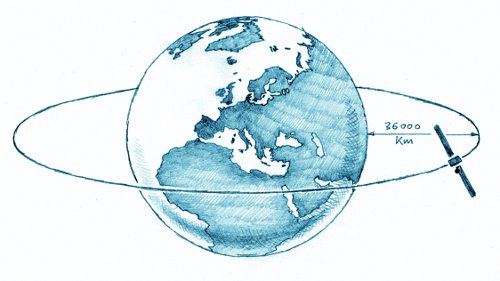Satellite Orbits
DID YOU KNOW?
Arthur C. Clarke, son of an English farming family, first set out the principles of the Geostationary Orbit in 1945. It took around 25 years for the first GEO spacecraft to appear.
Most often used orbits for communications satellite are geostationary, low-earth orbit, Molniya and medium-earth orbit.
Gesostationary Orbit
A satellite in a geostationary orbit appears to be in a fixed position to an earth-based observer. A geostationary satellite revolves around the earth at a constant speed once per day over the equator. The geostationary orbit is useful for communications applications because ground based antennas, which must be directed toward the satellite, can operate effectively without the need for expensive equipment to track the satellite’s motion.

As mentioned, geostationary satellites are constrained to operate above the equator. As a consequence, they are not always suitable for providing services at high latitudes: at high latitudes, a geostationary satellite will appear low on the horizon, affecting connectivity and causing multipath.
Low Earth Orbit (LEO)
LEO is typically a circular orbit about 400 to 900 kilometres above the earth’s surface and, correspondingly, has a much shorter period (time to revolve around the earth) of about 90 minutes. Because of their low altitude, these satellites are only visible from within a small area (about 1000 km radius) beneath the satellite as it passes overhead. In addition, satellites in low earth orbit change their position relative to the ground position quickly. So even for local applications, a large number of satellites are needed if the mission requires uninterrupted connectivity. For this reason, LEO satellites are often part of a group of satellites working in concert otherwise known as a satellite constellation. Low earth orbiting satellites are less expensive to launch into orbit than geostationary satellites and, due to proximity to the ground, do not require as high a signal strength.
Molniya - Highly Elliptical Orbit
Molniya orbits can be an appealing alternative. The Molniya orbit is highly inclined, guaranteeing good elevation over selected positions during the northern portion of the orbit. (Elevation is the extent of the satellite’s position above the horizon. Thus, a satellite at the horizon has zero elevation and a satellite directly overhead has elevation of 90 degrees).The Molniya orbit is designed so that the satellite spends the great majority of its time over the far northern latitudes, during which its ground footprint moves only slightly. Its period is one half day, so that the satellite is available for operation over the targeted region for eight hours every second revolution. In this way a constellation of three Molniya satellites (plus in-orbit spares) can provide uninterrupted coverage. Molniya satellites are typically used for telephony and TV services over Russia. Another application is to use them for mobile radio systems (even at lower latitudes) since cars travelling through urban areas need access to satellites at high elevation in order to secure good connectivity, e.g. in the presence of tall buildings
Medium Earth Orbit (MEO)
MEO is the region of space around the Earth above low Earth orbit and below geostationary orbit . The most common use for satellites in this region is for navigation, such as the GPS (with an altitude of 20,200 kilometres), Glonass (with an altitude of 19,100 kilometres) and Galileo (with an altitude of 23,222 kilometres) constellations. Communications satellites that cover the North and South Pole are also put in MEO. The orbital periods of MEO satellites range from about 2 to 24 hours. Telstar, one of the first and most famous experimental satellites, orbits in MEO.